#InRdg
Explore tagged Tumblr posts
Text

I run an informal altered book/collage workshop on the 2nd Monday evening each month. I started making another altered book just for this event…
…& It took so few pages before the moths and lichen started to show up. I tried to do sth else, honestly I did, but it seems I can't help it 🤷😂🦋🦋🦋
The paper folds are ones my co-host Neile has taught us during the workshops. She's ace at papercraft 😁✂️📚
#altered book#altered books#pritt stick collage#collage video#collage#mixedmedia#mixed media#artist book#art class#art workshop#reading uk#whats on reading#InRdg#Reading Berkshire
33 notes
·
View notes
Text


Ever wanted to start an altered book?
If you're in Reading (UK) I'm co-hosting an altered book workshop on 12 May, 6:30pm, Rising Sun Arts Centre, Silver St - tickets at https://alteredbooksmay2023.eventbrite.co.uk/ ✂️📚
All materials provided to start making your own altered book, or you're welcome to bring your own book/collage materials and join in with us!
#altered books#altered book#artist book#mixed media#collage#paper crafts#book crafts#art workshop#art class#workshop#reading uk#rdguk#rdg#berkshire#whats on reading#inrdg
25 notes
·
View notes
Text
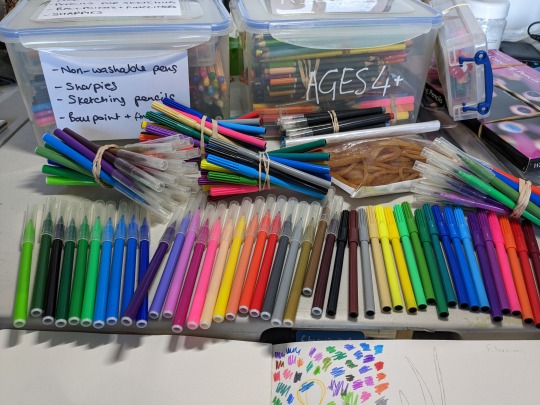
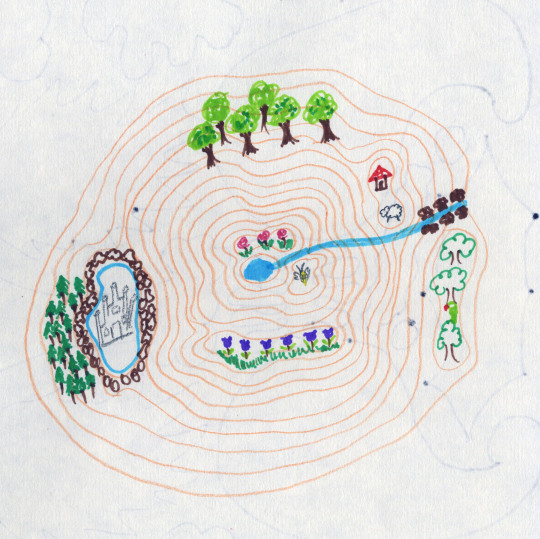


Dice doodles workshop 28-Jan-2023
Thanks to everyone who came to Saturday’s doodle session, & thanks to Maria for the biscuits!
Here are all the doodle games we played, and some suggestions for variations. Our aim is always for these doodles to be short, require no particular drawing skills, and be possible to do in a single pen on lined paper (so you can repeat them even when you don't have many art supplies handy)...
Our next workshop is on Saturday 25th February 2pm at the Rising Sun Arts Centre, Reading and tickets are at https://dicedoodlesfeb2023.eventbrite.co.uk
~
Warm-up & intro doodles
1) Maria’s favourite doodle
This is Maria’s favourite space-filling doodle and, although it doesn’t use any dice, it’s a good warm-up/down exercise to ease you into a doodling frame of mind.
Draw irregular blobs quite close to each other all over your page
Connect adjacent blobs by drawing short, roughly parallel lines between them – see the images below, I think they look a bit like like the rungs on a ladder
Where you find an intersection of 3 or more blobs that is hard to fill with lines, draw a small circle
You can fill in the blobs with patterns or colours
Find a video of this doodle in paint here, and some more easy warm up/down space filling doodles here and here.


~
2) Easy grid doodle: every Nth cell
This doodle uses 1 x D6 (six-sided die) to choose where to draw small symbols in a grid. In the workshop we asked participants to arbitrarily choose symbols but you could use another die, e.g. a D12, and assign a symbol to each number on it.
Draw a rough grid that fills your page – for this starter exercise, 6 or 7 columns and rows is enough, but you can draw as many as you like (it will just take you longer the more cells you have in your grid)
Pick an arbitrary symbol (triangle, heart, spiral etc) and roll a D6 to get a number (N)
Draw your symbol in every Nth cell of your grid – example: if you picked a triangle and rolled a 3, draw a triangle in every 3rd cell of the grid
Pick another symbol, roll again and draw your next symbol in every Nth cell. Repeat until your cells are full, or decide you’re finished
It doesn’t matter if you count your cells in a horizontal or vertical direction
It also doesn’t matter if you draw big symbols over each other, or small symbols so that they don’t overlap when you have multiple symbols in a cell
If you’re drawing in colour and have a full set of dice, as well as adding a D12 to pick symbols, you could add one more die to choose which colour you draw in. You could alternatively use a shuffled deck of cards - pick symbols using card face value, and colour using suits.
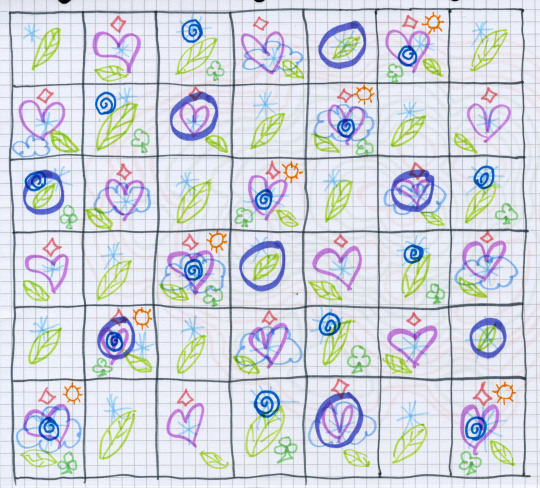

~
3) Abstract contours
Ahh this is a Random Doodle Club classic; a loop and layers doodle (or a blobs and lines doodle. Whatever you feel like calling it.) Today we used an odd/even rule to choose whether to draw a blob, or a line around it. You could just as easily flip a coin to do the same.
Draw a small circular(ish) blob in the middle of your page
Roll any die. If the number rolled is odd, draw a line around your blob. If it’s even, draw another blob-shape
Repeat drawing lines around the whole of your pattern/more blobs, until you run out of space
This can be done using one pen, or several colours. You can assign colours to different numbers if using a die. If you make the pattern using a black pen it can be coloured later.
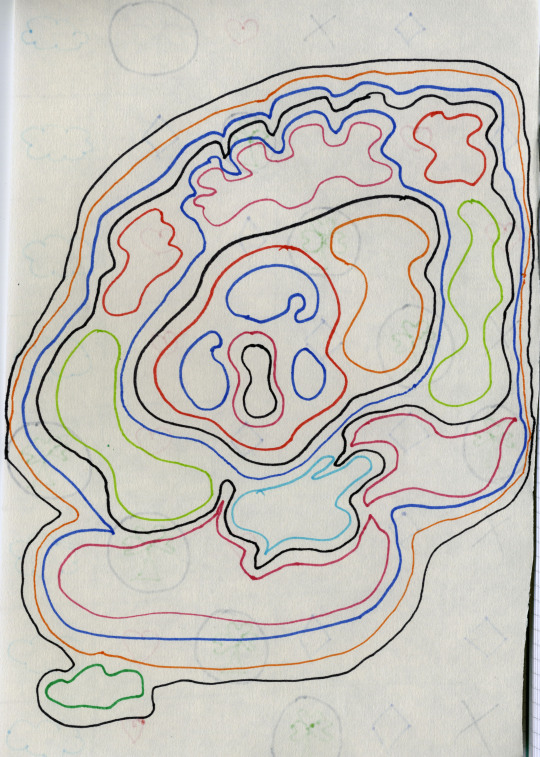
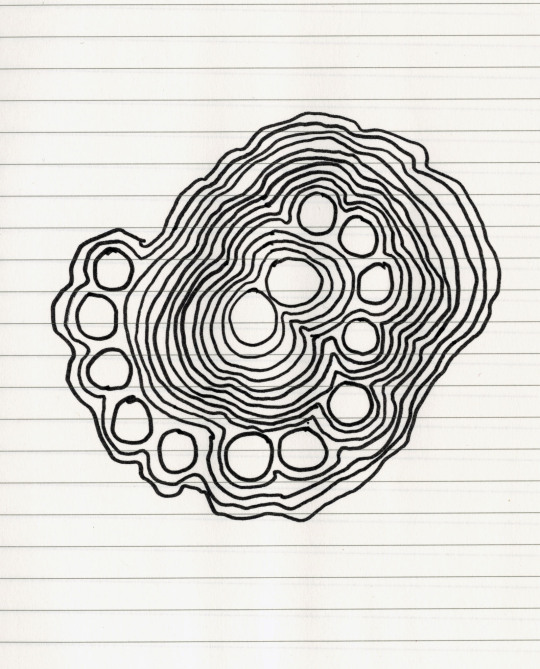

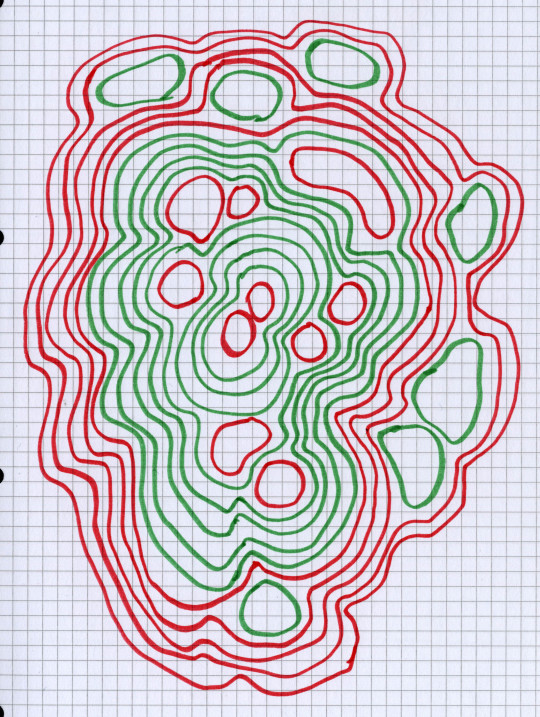
Variations include:
Instead of drawing a single blob/line, roll an extra die to decide how many blobs/lines to draw each turn
Use a larger die (e.g a D12) and higher/lower rule instead of an odd/even rule – draw a blob if you roll a higher number than your first or previous roll, and a line if lower. Higher/lower rules often lead to a different pattern in your drawing compared to odd/even rules.
There are more complex layer drawings from past workshops here:
https://www.immysmith.net/blog/2020/4/14/leaflayerdrawinggame
https://www.immysmith.net/blog/2021/mpls3
https://www.immysmith.net/blog/bookface-doodle-diaries
https://www.immysmith.net/blog/6-rule-drawings
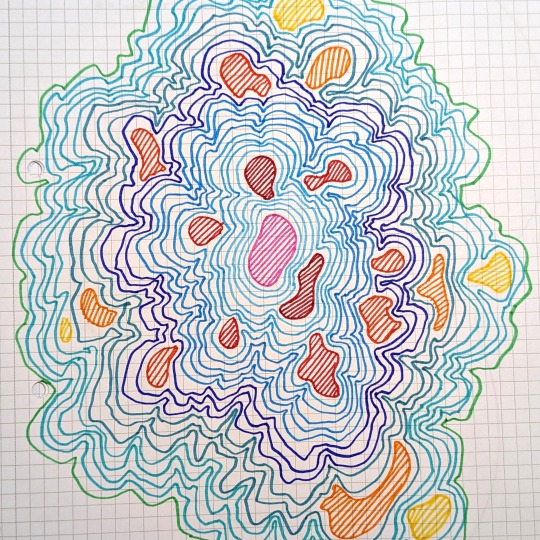
~
4) D6 Island
This activity uses the contour pattern from the previous game as the basis for a map of an imaginary island.
Make a contour pattern as in the previous activity using a light-coloured pen or pencil. Try to make your blobs a little larger, and pinch your lines together in places to create some steep contours
Each blob will represent a flat area of land, and we can use dice to decide what lives or is built there. For each one, roll a D6 to fill each in turn with shapes/colours/patterns using the list below to decide what each area contains:
1 = meadow
2 = pond or lake
3 = house
4 = livestock (e.g. sheep)
5 = orchard or beehives
6 = castle/tower or other tall building e.g. a lighthouse


For each steep area of your island where contours are very close together and form valleys, roll a D6 to choose what to draw in that valley:
1-2 = a river springing from an underground source or a lake, and running down to the edge of the island
3-4 = a forested area with trees and shrubs
5-6 = a cool rock formation, a scree (lots of small stones,) or a boulder field. Rocks basically, is what we’re after here
If any areas look a little bare, you can fill them in with more buildings or natural features in whatever way you like or come up with a dice rule to fill them. You can also add some sea around your island, draw it a flag, or add any other features you want.




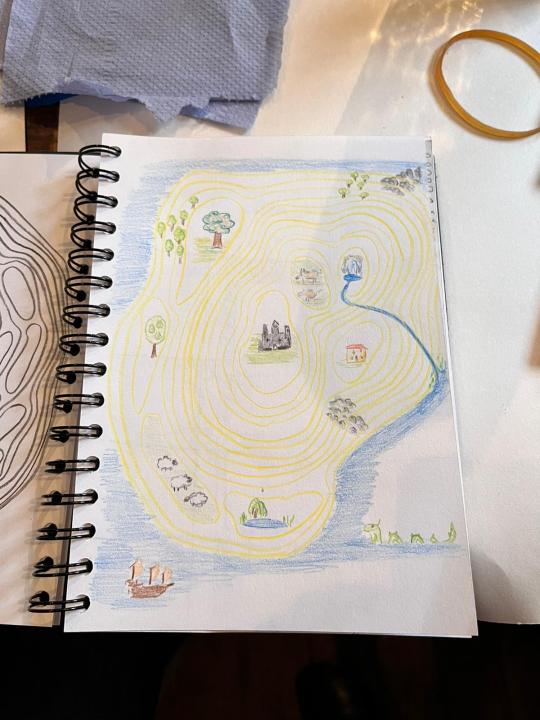


~
5) Grid doodle: frames and borders
Divide your page into a grid with 5-7 columns and rows. You want enough cells to keep your drawing varied, but not so many that each cell is too small to draw in. Here’s a doodle made with a 6 x 5 cell grid on an A4 page:

For each cell in your grid, roll a die/flip a coin
If the result is odd/heads, draw a smaller shape in the cell to create an internal border – any shape is fine, but bear in mind you will be adding patterns to the border and doodling inside the border too
If the result is even/tails, leave the cell blank and move on to the next
Pick 6 colours of pen or pencil and assign them to each number for a D6. Then roll for each cell in your grid, to choose which colour to either fill the border or the whole of each cell
Pick 6 patterns you can draw in a cell border, and for each cell with a border, roll a D6 to choose the pattern. Go over your coloured border making patterns in a darker colour. Example patterns:
1 = stripes
2 = spots
3 = hearts
4 = flowers
5 = X’s
6 = teardrops
Pick 6 lovely things to doodle (tree shapes, flowewrs etc) and, for each cell, roll a D6 to choose which thing you will draw in it – either fill the whole of a coloured cell with that thing, or draw your shape in the blank space of a cell with a border. Examples are:
1 = Trees
2 = Fungi
3 = Bugs
4 = Flowers
5 = Clouds/weather
6 = Love hearts
Colour any of your shapes as much as you like.
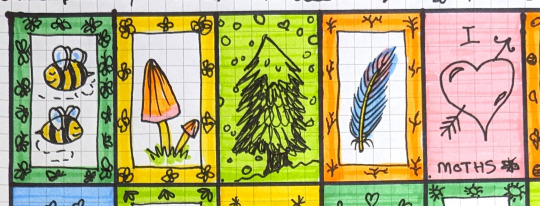
This game also works in black and white if you skip the colouring step, and you can always colour it in later.
Video for another grid doodle is here
There are many possible variations on these grid games, using more dice to pick shapes for inside borders, different colours for borders and whole cells, and a larger array of patterns. You can also use a shuffled deck of playing cards and use the card pip shapes (spade, heart, club, diamond) as border motifs, then use the card numbers to choose from 13 lovely things to draw inside your grid cells.
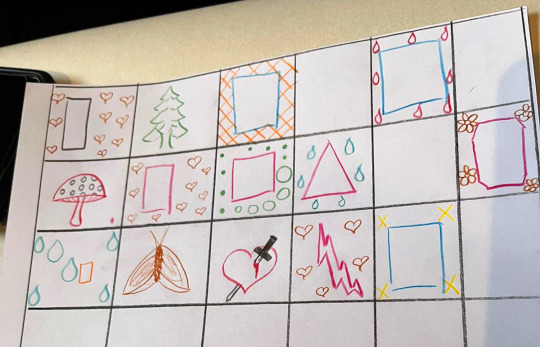
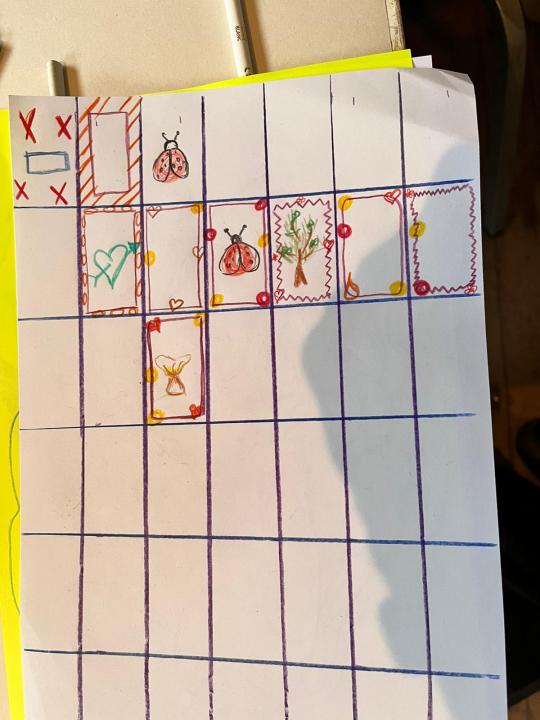
~
6) Warm-down: ripples on a pond
To warm down we drew an oval outline filling a page to represent a pond. Then we made simple space-filling ripple patterns using a die to choose the number of ripples at any point in our pond.
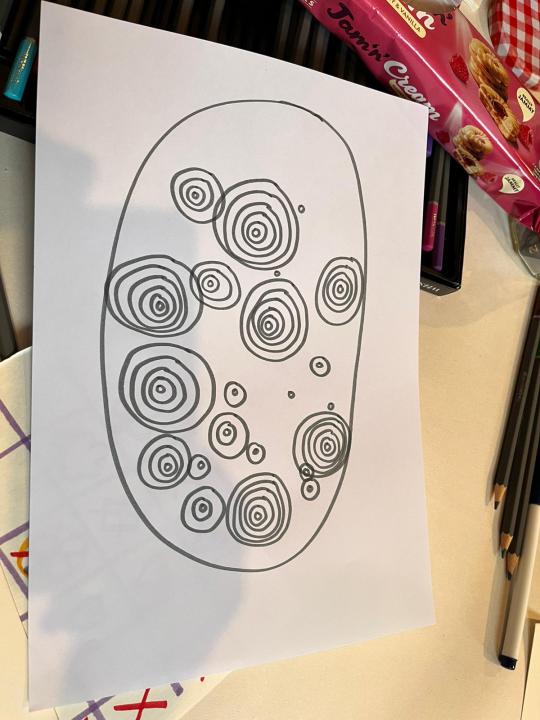


You could assign colours to the ripples you draw using another die. You could divide the pond into segments and use another die to decide which segment you put your ripples in. You can also place ripples around the pond using a D8 as a compass or a D12 for clock points – some examples of using dice to determine direction can be found at https://curiouslyfoxy.blogspot.com/2022/06/junes-random-doodle-club.html

~
That's all the activities for our starter workshop, thanks again to everyone who joined us. The next 2 workshops are on the 25 Feb and 25 Mar.
#doodle#doodles#dice#dice doodles#art class#art workshop#workshop#reading#berkshire#rdg#rdgUK#inrdg#whats on reading#rising sun arts centre#ink doodle#ink sketch#pencil sketch#sketch#sketchbook#drawing game#drawing games
5 notes
·
View notes